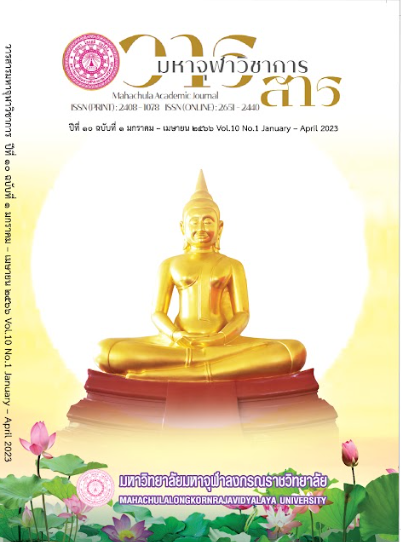The Four Noble Truths : The Unique Teaching of Buddhism
Main Article Content
Abstract
Prior to discovery of the Lord Buddha, it underestimated the number of religions and cults. However, the Buddha's teachings and practices are core in two parts : (1) Kamasukkhallikanuyoga, the extreme of sensual indulgence or extreme hedonism and consist of various rituals (2) Attakilamathanuyoga, the extreme of self-mortification to achieve the end of suffering. The Lord Buddha was born to help all sentient beings free from dukkha, but he refused to accept both of two practices. There are two Buddha's practical instructions to reach the end of suffering : (1) Anupubbikathā or Anulomasaccakatha, the Lord Buddha delivered the teaching from easy to difficult of generosity (Dāna), virtue (sīla), heaven (Sagga), sensual pleasure (Kāmānaṃ ādīnava) renunciation (Nekkhamma), like how to teach Venerable Yasa. Nevertheless, that was not the ultimate goal of Buddha’s teaching. (2) Saccā kathā or Sāmukkangsikathesānā by which arises the spotless immaculate vision of the Four Noble Truths as: as: (1) Dukkha ariya saccāni, the Buddha’s awakening from the truths of Five Aggregates of clinging are suffering (2) Samudaya ariya saccāni, the Lord Buddha’s awakening from the truths of craving for sensual pleasures (Kama Taṇhā), craving for a fixed identity (Bhava Taṇhā), craving to avoid pain(Vibhava Taṇhā), these causes of suffering. (3)Nirodha ariya saccāni, the Lord Buddha’s awakening from the state of cessation of suffering. (4)Magga ariya saccāni, the Lord Buddha’s awakening from the way to the end of suffering by Eightfold Path, and wisdom (Paññā) as a leader. Once, the Lord Buddha preached first sermon of five ascetics to cultivate mental states and to find liberation by ending of Kilesa to Nirvana, whereas the Saccā kathā does not practice in any religions. Therefore, the Four Noble Truths are the unique teaching of Buddhism.
Article Details

This work is licensed under a Creative Commons Attribution-NonCommercial-NoDerivatives 4.0 International License.
References
พระพรหมคุณาภรณ์ (ป. อ. ปยุตฺโต). พุทธธรรม. พิมพ์ครั้งที่ ๗. กรุงเทพมหานคร: มหาจุฬาลงกรราชวิทยาลัย, ๒๕๔๑.
_________. ลักษณะแห่งพระพุทธศาสนา. พิมพ์ครั้งที่ ๔. กรุงเทพมหานคร: มูลนิธิพุทธธรรม, ๒๕๓๙.
_________. แก่นแท้แห่งพระพุทธศาสนาและอัตลักษณ์แห่งพระพุทธศาสนา. กรุงเทพมหานคร: กรมการศาสนา กระทรวงวัฒนธรรม, ๒๕๕๔.
_________. พระพุทธเจ้าตรัสรู้อะไร. กรุงเทพมหานคร: คิงออฟแอนด์เวอร์ไทซิ่ง, ๒๕๕๕.
พระพรหมบัณฑิต (ประยูร ธมฺมจิตฺโต ). พระธรรมเทศนา ๖๑ กัณฑ์. กรุงเทพมหานคร: หจก.สามลดา, ๒๕๕๙.
พระพรหมโมลี (วิลาส ญาณวโร). วิมุตติรัตนมาลี. กรุงเทพมหานคร: มิตรสยาม, ๒๕๓๙.
พระพุทธโฆสาจารย์. วิสุทธิมรรค. สมเด็จพระพุฒาจารย์ (อาจ อาสภมหาเถร) แปลและเรียบเรียง. พิมพ์ครั้งที่ ๖, Taiwan,R.O.C., ๒๕๔๘.
_________. วิสุทฺธิมคฺคปกรณํ (ทุติโย ภาโค). มหาจุฬาลงฺกรณราชวิทฺยาลเยน ปกาสิตา. กรุงเทพมหานคร: โรงพิมพ์วิญญาณ, ๒๕๓๙.
พระพุทธรักขิตเถระ. ชินาลังการ. พระคันธสาราภิวงศ์แปลและอธิบาย. กรุงเทพมหานคร: ประยูรสาส์นไทยการพิมพ์, ๒๕๕๒.
พระมหากัจจายนเถระ. เนตติปกรณ์. พระคันธสาราภิวงศ์ แปลและอธิบาย. กรุงเทพมหานคร: ไทยรายวันการพิมพ์, ๒๕๕๐.
_________. เปฏโกปเทสปกรณ์. มูลนิธิภูมิพโลภิกขุ แปล. กรุงเทพมหานคร: มูลนิธิภูมิพโลภิกขุ, ๒๕๕๘.
พระโมคคัลลานเถระและสุภูติเถระ. อภิธานปฺปทีปิกาและอภิธานัปปทีปิกาสูจิ. กรุงเทพมหานคร: มหากุฏราชวิทยาลัย, ๒๕๓๕.
พระเรรุกาเน จันทวิมละ สังฆนายกมหาเถระ. อริยสัจ ๔. ดร.สุนทร พลามินทร์ แปล. กรุงเทพมหานคร: สำนักพิมพ์จันทรเพ็ญ, ๒๕๕๔.
พุทธทาส. คริสธรรม พุทธธรรม. กรุงเทพมหานคร: ธรรมสภา, ๒๕๓๖.
มหาจุฬาลงกรณราชวิทยาลัย. พระไตรปิฎกภาษาบาลี ฉบับมหาจุฬาเตปิฏกํ ๒๕๕๐. กรุงเทพมหานคร: โรงพิมพ์มหาจุฬาลงกรณราชวิทยาลัย, ๒๕๓๕.
_________. พระไตรปิฎกภาษาไทย ฉบับมหาจุฬาลงกรณราชวิทยาลัย. กรุงเทพมหานคร: โรงพิมพ์มหาจุฬาลงกรณราชวิทยาลัย, ๒๕๓๙.
มหาวิทยาลัยมหามกุฏราชวิทยาลัย. พระไตรปิฎกและอรรถากถา ฉบับมหามกุฎราชวิทยาลัย. กรุงเทพมหานคร: โรงพิมพ์มหามกุฏราชวิทยาลัย, ๒๕๒๕.
สุภีร์ ทุมทอง. อริยสัจ ๔. กรุงเทพมหานคร: ภาพพิมพ์, ๒๕๕๗.
สุมงฺคลสามิเถโร. อภิธมฺมตฺถวิภาวินีฎีกา. กรุงเทพมหานคร: มหาวิทยาลัยมหาจุฬาลงกรณราชวิทยาลัย, ๒๕๔๒.


